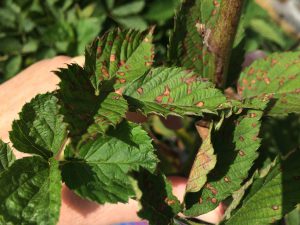10 Reasons Why Blackberry Leaves Turn Brown
Blackberry leaves are turning brown at a striking rate lately. It’s an ever-worsening situation for the poor berries and gardeners alike. They may have been succumbing to a number of issues, including infection, old age, and too much shade or water stress. Or it could simply be the climate change we’ve been warning about for some time now.
Regardless of the underlying reasons, growers are looking for a solution. And perhaps more importantly: how to save what was once a bountiful harvest of sweet berries. Read on for some proven suggestions.

10 Reasons Why Blackberry Leaves Turn Brown and How To Solve It
1. Excessive Watering
Most blackberries are in the ground for 2 to 3 years before harvest. In that time, the roots need room to spread and grow, as well as plenty of moisture to survive. However, too much water can lead to root rot and decay of established roots.
Root rot will occur in wet weather and it will begin with declining leaf size and browning leaves at the tips of branches. Roots will eventually rot and the berries will start falling from the plant.
What is the solution?
Water berries early in the morning. This allows the plants to dry throughout the day and the leaves are less likely to be injured by excessive moisture.
If the wet soil can’t be dried out by a period of dry or cold weather, or with extra mulch, then it may be necessary to dig up and transplant your plants, which also can sometimes be recommended by a local horticulturalist.
2. Salt Buildup
Salt buildup on a soil can cause leaves to turn brown, yellow, or both. It is caused by excess moisture, high humidity, and/or poor drainage. The salt will penetrate into the root zone of plants and damage the roots.
What is the solution?
Reduce excessive watering and add compost to the soil every fall when planting blackberry plants for a balanced nutrient supply for all seasons.
3. Old Age
Sometimes, older plants just get tired and stop producing healthy new growth. The roots tend to weaken and the plants become sickly and susceptible to disease.
What is the solution?
Prune off the old canes and prune the plant back to 6-inches tall. Make sure you keep the area around your plants clear of any branches or debris that may harbor disease. Heavily mulched areas or areas with dead grasses and weeds may be a source of disease, so remove these areas from your garden.
If your planting is mature and it’s simply too old to produce, then dig up the plant and replace it with a younger bush, which will hopefully live on for another 5 to 8 years or more. You can do this in December or early spring.
4. Fungal Infection
Fungi can come onto a plant and cause it to become infected. Fungus will attack the roots and eventually kill the plant. The leaves will turn brown first, then die, and more often than not, drop off.
What is the solution?
Fungi are a natural part of the ecosystem, but they can make plants sick when they invade through open wound sites such as stems and foliage.
Natural remedies may include compost tea or organic fungicide. Fungicide spray is unnecessary if using compost tea.
5. Pests
Insects and fungi may invade a blackberry plant and cause it to become infected. They can also be disease carriers by transferring from plant to plant.
What is the solution?
Wear rubber gloves when working around plants that are infected. Or, you can use a commercial insecticide if you intend to pick your berries. Fungi are common in soil and are easily treated with many organic sprays.
6. Heat Stress
The stress of excessive heat can cause a plant to stop producing new leaves and berries. This is very common in areas south of the Mason-Dixon line, where it’s extremely hot and muggy during the summer months.
Too much exposure to the sun during the hottest part of the day can cause damage to the plant’s roots.
What is the solution?
Rotate your plants so that you give them an even amount of direct sun for two months during the growing season. On hot days, move plants into a shaded location.
Use mulch in gardens to help shade plants from solar rays and help reduce evaporation of water. If a heavy mulching system isn’t practical, use a lighter blanket over blackberry bushes.
Plant blackberries in well-drained soil, with plenty of air circulation, to reduce the impact of excessive heat. The fruits will be smaller in size but should be sweeter with a better flavor.
7. Chemical Stress
Exposure to some pesticides can cause a plant to become sickly and die. This includes synthetic chemicals, like those in organophosphates and chlorinated hydrocarbons.
Applying potassium-heavy fertilizers can also cause plants to turn brown and become soft.
What is the solution?
Check the label carefully if you use a commercial chemical to treat your garden or plants. Weed out diseased and pest-infested plants before applying any type of spray to your garden area.
Try cutting back on your fertilizer use by a quarter or half and replace with compost or compost tea. Organic fertilizer and compost can boost plant growth and improve the soil condition.
8. Wrong location or Climate
Blackberry plants will do very well in a variety of climates. However, heavy clay soils may lead to root rot and slow growth, especially after heavy rains. Blackberries grown in too much shade will not fully mature and will result in lower yields.
What is the solution?
Plant your blackberry bushes only where they can grow into full size and produce maximum yield over the years. Research throughout different regions to determine the best climate for your plants!
9. Soil pH
Blackberry plants require a soil with a pH of at least 6.8 to thrive. Plants grown in soil with too much acidic content can develop symptoms of iron deficiency, while plants grown in soils with too much alkaline content may be prone to root rot, fungus, and pests.
What is the solution?
Raise the pH of your irrigation water by adding an acid fertilizer or limestone from an organic farm supply company. If you live in a drought area, then raise the pH to 7.5. If you live in a humid area, then lower the pH to 6.5.
10. Bacterial Leaf Spot
Bacterial leaf spot emerges as brown or black blotches on leaves, while the rest of the leaf might yellow and fall off. Infected leaves will eventually turn brown and die, with the infection spreading to new growth. Severe infections can lead to defoliation of blackberry plants within a few weeks.
What is the solution?
Apply one of several bacterial fungicides, such as potassium bicarbonate, to the soil around blackberry plants to kill the bacteria. Or, add a slow-release nitrogen fertilizer. The fungus grows in high acid soils where soil pH is low (below 6.5). Add lime to raise soil pH above 6.5 for more complete disease control and less chance of defoliation.
11. Not Enough Light
Blackberry plants require at least 6 hours of sunlight each day if they are to be productive. If you live in a climate where it gets too hot for the plants, then move them to a shadier location for better productivity. This will help offset the summer heat stress.
What is the solution?
Plant your blackberry bushes in a location that provides at least six hours of bright light each day, without direct sun exposure. Research your climate to determine the best location for your blackberries!
12. Nematodes
The presence of nematodes in the soil is not typically a major problem for established blackberry bushes, but young ones will suffer greatly if they are present. Root nematodes are the most common type of nematode and they destroy roots by feeding on them.
What is the solution?
Apply beneficial nematodes to your soil to bring down the number of root-eating nematodes in your soil. Beneficial nematodes are microscopic organisms that feed on other types of organisms in the soil, such as fungus, slugs and insects.
Planting Position
Blackberries can be planted in many different ways. The two most common ways are in the ground, and in containers.
Ground-Planted Blackberries
Blackberries are best planted in a sunny area. If you’re growing them on a slope, make sure to select the sturdiest plants possible—the soil can get very heavy and hard to manage once wet. Once planted, you will want to give them extra support against weeds and critters by creating a trellis or fence.
Container-Planted Blackberries
Blackberries can be planted in a container of any kind, ranging from standard potting soil to a wooden frame bush. Plant each plant deep enough that the entire root ball is covered in soil. Water the plants well so they settle into the soil, then add additional fertilizer and compost around each plant as needed.
Tips to Grow Blackberry Optimally
Here are several tips to help you plant your blackberry plant and get the most it.
1. Plant outside
Blackberries prefer full sunlight and open areas, so getting them outside will help produce the best crop for you. If your soil is heavy and clay-ish, then you will want to get them in a well-drained area. It’s ideal for blackberries to be planted in fertile, loose soil that’s around four inches deep.
2. Start Young
Young blackberry plants are more likely to grow strong, sturdy roots that mean a healthy growing season for you. You will want to choose smaller plants, though don’t worry about the age of the plant, five-year-old blackberry bushes can grow well!
3. Mulching
Mulch is essential for preventing weeds from sprouting around your plants. It’s also important to keep the mulch two inches away from your plant stems or trunks, so they don’t get slimy and moldy.
4. Containers
If you’re on a smaller budget, then blackberry plants can be grown in pots. Be sure to get the right size container—make sure it has at least six inches of drainage space at the bottom and is large enough to hold your plant’s root ball.
5. Humidity and Heat
The ideal temperature for growing blackberries is 65°F, with rapidly drying winds that don’t stay hot too long. Too much heat will dry out your plants, while too much humidity will lead to mold and fungus.
6. Fertilizer
Blackberries require several fertilizers to grow properly. You’ll want to make sure you put in nitrogen-based fertilizers, as well as organic compost or manure to add more calcium and potassium. At the same time, don’t forget about phosphorous, which is another great fertilizer that blackberries need!
7. Watering
Blackberry plants will require more water than most plants in the first year, but they should need little to no watering once they are established. If your plant is not growing well or has died, then water it well until it starts to grow again. Experiment with the amount of water—water thoroughly, but not too much!
8. Pruning Blackberry Bushes
Blackberry bush pruning will encourage new growth, which is essential for a healthy plant that produces a lot of berries. You can start pruning in the spring when the new shoots grow about 6 inches high. During this time, you’ll want to remove any dead canes and any canes that go towards the center of your plant.
9. Pest Control
Blackberry plants love humidity, but too much humidity will cause fungus and mold, especially after rains. You’ll want to monitor your plants for any insect infestation, and you may need to try several different methods to get rid of pests.
10. Frost Protection
Blackberry plants are unlikely to survive hard frost. If you live in a climate that gets frost often, then make sure to protect your blackberry plant with plastic sheets or cloth. Blackberry plants need light to grow, so don’t forget to take off the covering after a few hours.


